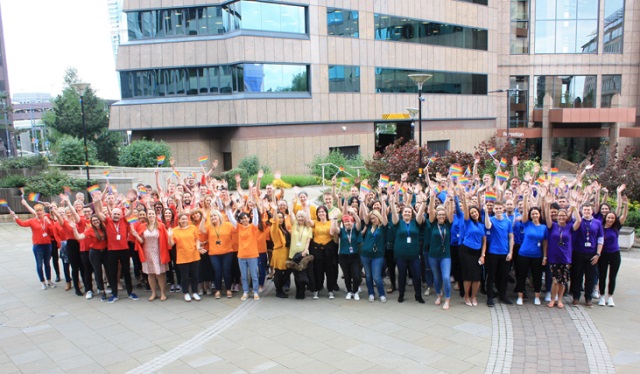Our Roadmap To Building A Successful DE&I Strategy

The case for a robust Diversity, Equity and Inclusion (DE&I) strategy in the workforce has become increasingly important to business leaders over recent years.
Creating a diverse workforce is, first and foremost, the right thing to do. At Hays, one of our core values is to “do the right thing”; it is absolutely the right thing for DE&I to be a firm fixture on every board agenda. In our view, it is essential that the DE&I strategy is owned by our business leaders and not regarded as the sole responsibility of the HR departments.
A diverse workforce, operating in an inclusive environment with equity of opportunity and outcomes, benefits every aspect of what we do, so we ensure that the whole business is involved in the agenda.
We have long understood the importance of diversity and how it shapes the decisions we make for our customer experience. Having the opinions and vision of those who have a different lived experience to your own is crucial if we are going to understand the needs and ambitions of all our customers and stakeholders.
Businesses with a diverse leadership team not only create a vastly better workplace culture for their employees, but they are more productive and profitable, and demonstrate greater agility and innovation in their markets. As noted in this McKinsey report: “Published research from academia, corporations, and other organizations supports that diverse and inclusive groups make better quality decisions, often faster, and in a more fact-based manner, with less cognitive bias or groupthink.”
However, it seems as though many organisations are struggling to make inroads into their DE&I plans. A European survey by Workday found that 75% of those questioned had a dedicated diversity budget. Despite this, over a third had no strategy. A report from Hays Canada found that only 29% of organisations have set DE&I goals in their recruitment process.
The last couple of years have brought issues around DE&I to the forefront of many of our minds. As leaders we have to ask how we personally can make a meaningful difference. Having done this myself, it has, at times, been a confronting experience, but one that I encourage other business leaders to take.
With International Women’s Day around the corner, I thought I’d share with you the DE&I journey that Hays is on, and the different stages of the process we have gone through, as well as our plans for creating a truly equitable and inclusive workplace. I hope it helps some of you navigate your own.
Vision
We have established a very clear vision of what we think diversity should look and feel like. We want all our businesses to reflect the markets and communities they serve; built on a culture of trust, respect, equity and inclusivity. This means that how we address the DE&I challenge will be different in each part of the world, but there will be a commonality of purpose. In a sense, this is the essence of diversity goals – shared purpose but with multi-dimensional components that may look different depending on where you are in the world, but the shared experience should ‘feel’ the same.
Commitment and Resources
In 2019, Hays created the Global DE&I Council as a commitment from our Executive Board, and really signalled the launchpad for our DE&I journey.
The role of the council is extremely important. It is the vehicle that has driven the dialogue on setting targets, and it is the main vehicle for communicating our plans, as well as the forum to debate and evolve these plans.
When a company announces their diversity plans, it’s an important signal of intent to both the internal organisation as well as the external world. Statements and commitments are released to highlight what is meant by DE&I and what is going to be done to address any issues.
Advocacy
Most companies initially sport their DE&I colours through advocacy. This may start via employee engagement on days of importance, such as International Women’s Day and Pride Month.
Celebrating these helps to create positive tensions, as your workforce will rightly ask, “if we celebrate awareness days externally, what are we doing internally to back this up?”

Hays staff in the UK celebrate Pride Month
You should use this momentum to empower allies. As described by Sheree Atcheson: “An ally is any person that actively promotes and aspires to advance the culture of inclusion through intentional, positive and conscious efforts that benefit people as a whole.” Encouraging people to be allies and giving them the tools to do so, will support your DE&I efforts.
Another important aspect of advocacy is the creation of Employee Resource Groups (ERGs), who, as described by Catalyst are: “Voluntary, employee-led groups that foster a diverse, inclusive workplace aligned with organizational mission, values, goals, business practices, and objectives.” Around the world, Hays have ERGs to ensure all our employees’ voices are heard at work.
We have also created Diversity and Inclusion Steer Cos (DISCOs), who raise issues and ask questions internally. They also help to promote our DE&I efforts externally and have played a key part in our journey.
Understanding
The need to “do something” has now been embraced. But what is that “something”? This is a difficult part of the process.
To support us, Hays recruited the help of Hatch Analytics, who lifted the lid on our organisation and helped us understand the task at hand, by asking our people for their views on our culture. This allowed us to realise what we wanted to achieve.
Even the best-intentioned corporations have blind spots. This part of the journey helped us identify any barriers, be they real or perceived, to getting into and getting on at Hays. Having an external organisation look at the bare facts was important as it was non-judgemental and with no hidden agenda – it was just the plain facts.
As a result of our findings, in 2020, we released Our Promise. Our Promise outlined our beliefs, our commitment and our actions, and was communicated internally to our staff.
Setting objectives
One thing we agreed on quite quickly (but not without rigorous debate!) was the need to establish targets. We believe in the importance of targets at Hays. What gets measured, gets managed. But targets are not the same as quotas and it was important to recognise targets are a tool to get to a better place, not the end in themselves.
Each business now has a range of DE&I objectives with measurable targets set against certain demographics or pillars of diversity. At a Global level we have also set a target for women in leadership. We see this as a logical start point as it impacts the largest number of people and is truly global in application. Like many organisations, our overall representation for women is not reflected in our most senior leadership ranks.
We’re doing some extensive investigatory work to help us unpick this issue and understand what we need to do differently to get to where we want to be. That target is to have women represent 45% of our senior leadership by 2025 and 50% by 2030.
While targets are becoming more apparent in more organisations these days, they are not yet widespread. In our experience, setting the targets has been a key catalyst for really meaningful action, without at all compromising the integrity of our development and promotion activities.
Action planning
Setting those targets prompted us to create a plan of action. While we had a global aspiration for gender targets, we gave our regions the freedom to develop their specific diversity plans and targets beyond this. There is no one-size-fits-all model when it comes to diversity and with a business operating in 33 countries around the world, each one has its own specific challenges.
As a part of our planning, our leaders have been through Conscious Inclusion training, which helps employees understand their own biases and their impact in the workplace. We are also cementing blind recruitment into our internal hiring process, challenging our established recruitment channels, hard-wiring diversity into the decision-making and setting balanced shortlists in the selection process.
There is much more to do to make this universal and consistent within the business, but from these established pockets of best practice we are creating a ‘global playbook’ for diverse and inclusive hiring.
Governance and Review
Diversity in the workforce is not a finite project. There is no end date. The targets we have set will keep us moving in the right direction, but we must all be aware of changing dynamics.
With the help of our DISCOs and ERGs, we have a comprehensive regime at local and global level that help to spot gaps in our current thinking.
It is imperative that businesses stay engaged with employees and continue to monitor their own targets. Are they on track? Are they still appropriate?
My own lessons
At Hays, we are making good progress in our mission to create a fairer and more diverse workforce, but there is always more work to be done. While starting on a meaningful DE&I journey can feel daunting, it is one worth pursuing and once the first difficult steps have been taken, momentum builds quickly. If every single organisation, no matter how big or small, moved their own dial, our world would be so much better for all. As one of the leading players in the recruitment industry, if we can help our clients along their own journey, then our impact is massively leveraged too.
It is important to investigate your own businesses and to be open to what you find. Sometimes, if what we see isn’t quite what we would like, we rationalise it away and move on. But while flaws in your make-up aren’t necessarily the fault of any one individual, or of a previous plan or policy, neither are they there without cause. A lesson for me was to accept what we found as the truth, and seek to understand and improve, as opposed to dispute and defend. After all, once the facts are there for all to see, there can be no excuse for then doing nothing.
Paint a picture of why the destination you are headed to is better than today’s situation and make sure people know there is benefit in this for everyone, not just selected groups. Set targets and communicate them.
I hope sharing the Hays DE&I story benefits and helps other companies.
Did you enjoy this? You might like:
- WHY COMPANIES MUST GET SERIOUS ABOUT HYBRID HIRING
- The future of leadership in technology
- SOLVING THE DIGITAL SKILLS GAP REQUIRES INNOVATIVE THINKING. HERE’S WHAT BUSINESSES CAN DO
 ALISTAIR COX
ALISTAIR COXChief Executive
Alistair has been the CEO of Hays, plc since Sept. 2007. An aeronautical engineer by training (University of Salford, UK, 1982), Alistair commenced his career at British Aerospace in the military aircraft division. From 1983-1988, he worked Schlumberger filling a number of field and research roles in the Oil & Gas Industry in both Europe and North America. He completed his MBA (Stanford University, California) in 1991 and returned to the UK as a consultant for McKinsey & Co. His experience at McKinsey & Co covered a number of sectors including energy, consumer goods and manufacturing.
He moved to Blue Circle Industries in 1994 as Group Strategy Director, responsible for all aspects of strategic planning and international investments for the group. During this time, Blue Circle re-focused its business upon heavy building material in a number of new markets and in 1998, Alistair assumed the role of Regional Director responsible for Blue Circle’s operations in Asia, based in Kuala Lumpur in Malaysia. He was responsible for businesses in Malaysia, Singapore, the Philippines, Indonesia and Vietnam. Subsequent to the acquisition of Blue Circle by Lafarge in 2001, he also assumed responsibility for Lafarge’s operations in the region as Regional President for Asia.
In 2002, Alistair returned to the UK as CEO of Xansa, a UK based IT services and back-office processing organisation. During his 5 year tenure at Xansa, he re-focused the organisation to create a UK leading provider of back-office services across both the Public and Private sector and built one of the strongest offshore operations in the sector with over 6,000 people based in India.

The job interview
The word you are saying too much in job interviews
Discussing your salary expectations
Answering competency-based interview questions
Answering behavioural job interview questions
How to answer, “Why should we hire you?”
Questions to ask following the pandemic outbreak”
How to deal with a counter offer



